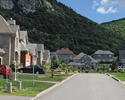The dreadful death of George Floyd lit a fire that threatens to burn down America’s cities. Already losing population before the pandemic, our major urban centers have provided ideal kindling for conflagration with massive unemployment, closed businesses and already rising crime rates. read more »
Housing
The Twilight of Great American Cities is Here. Can We Stop It?
- Login to post comments
House Hunting with Temple Grandin
Many of you will be familiar with Temple Grandin. She’s the autistic woman who designs slaughterhouses from the cattle’s perspective. By organizing the process in a way that’s calming to the animals it improves efficiency. Her primary contribution is the recognition that animals are highly sensitive to small symbolic details: a shadow, a dangling chain, a hose left on the ground, a flapping flag. read more »
- Login to post comments
Social Bonds are Fraying Fast in America's Cities
The evening cheers in support of health care workers during the worst of New York’s coronavirus outbreak were a rare bright spot in a day full of depressing developments. read more »
- Login to post comments
Combined Statistical Areas: Ready for the Dispersion Demand
The years to come seem likely to see America’s historic population dispersion continue or accelerate, as pandemic and lockdown worries have severely reduced the attractiveness of dense urban cores (especially in the highest density areas, such as New York City). As a result, the sparsely populated outer areas of combined statistical areas (CSAs), the largest category of local labor market defined by the Office of Management and Budget (OMB), could be the destination of many former urban core households. read more »
- Login to post comments
The Changes Coming to Australia's Residential Property Market 'After' the Virus
The COVID-19 virus has taken a hammer to many of the ideas we have about what is normal.
It is obvious now that many things will never be the same.
COVID-19 follows a period of significant change for Australia’s residential property market. read more »
- Login to post comments
Is the California Dream Finished?
For all the persistent rhetoric from California’s leaders about this state being on the cutting edge of social and racial justice, the reality on the ground is far grimmer. read more »
- Login to post comments
How the Virus Is Pushing America Toward a Better Future
Pessimism is the mood of the day, with 80 percent of Americans saying the country is generally out of control. Even before civil unrest and pestilence, most Americans believed our country was in decline, Pew reported, with a shrinking middle class, increased indebtedness and growing polarization. read more »
Neo-Feudalism in California
From the beginning, California promised much. While yet barely a name on the map, it entered American awareness as a symbol of renewal. It was a final frontier: of geography and of expectation.
—Kevin Starr, Americans and the California Dream: 1850–1915 read more »
- Login to post comments
Highest Salaries for Software Developer Remote Work (Metro Areas)
COVID-19 lockdown and social distancing strategies have led to a huge increase in the number of people working at home (working remotely). According to Gallup, by mid-April, 62% of US employees were working at home. Further, Gallup found that about half of the remote workers preferred to continue working from home, with another quarter interested in remote working out of pandemic fears. read more »
- Login to post comments
Back to the Drawing Board?
The global response to the impact of the Coronavirus seems consistent in at least one respect: everything we previously took for granted is now up for grabs. Long held truisms, established patterns of corporate and individual behaviour, doctrinal teachings, professional articles of faith – nothing is immune from Covid-19 induced change. read more »
- Login to post comments






















